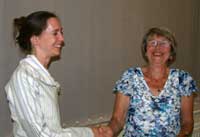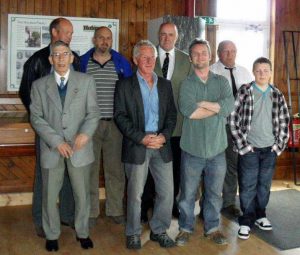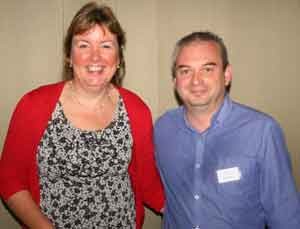See also the Restoration Grants page for restoration awards.
(Click on images to view full size)
2020 AWARDS
To encourage scholarship and investigation in the industrial archaeology field, the following awards were made to archaeologists, historians, professionals and students:
- The Peter Neaverson Award for Outstanding Scholarship went to Wayne Cocroft and Paul Stamper for Legacies of the First World War: Building for total war 1914-1918, published by Historic England
- There were two Publication Awards, which went to:
- Martin Green and Michael Jeffs for The Ironmen of Leamington: Iron-founders and allied traders in Royal Leamington Spa 1800-1900, published by Warwickshire Industrial Archaeology Society
- David Dungworth for Glassworking in England from the 14th to the 20th century, published by Historic England
- Two Research Grants were awarded to:
- Andrew Fielding for a re-appraisal of the salt making site at Crosscanonby, Allonby Bay (£848)
- Norman Redhead for an investigation of test pits at Marple Lime Kilns, Greater Manchester (£1,500)
2019 AWARDS
Left to right: John Bowman, John Pickin (Geoff Wallis, Marilyn Palmer) David Pope. Penny Middleton, Peter Brown, Anne Andrews, Jim Andrews, John Robinson
2018 AWARDS
2017 AWARDS
2016 AWARDS
2015 AWARDS
2014 Awards
2013 AWARDS
FIELDWORK AND RECORDING AWARDS 2012
Alvaro Mora-Ottomano won the Funded Award for Archaeological Building Recording and Investigation, Royal Worcester Porcelain Works – The Bone Mill.
The Unfunded Award went to John Barnatt, on behalf of the PDMHS Conservation Team for High Rake Mine, Little Hucklow, Derbyshire. Excavations and Conservation at an Important Nineteenth Century Mine in Mining History Vol 18 Nos 1 and 2 Summer/Winter 2011.
The Student Fieldwork and Recording Award went to Fiona Deaton Tankerville Lead Mine Conservation Management Plan and the Postgraduate Dissertation Award to Fiona Fyfe (left) From Factory to Flowers: An investigation into the transfer of industrial heating technology to country house gardens.
There was also a highly commended award: Kate Mitchell, The Sustainability of Bottle Kilns in Stoke-on-Trent.
PUBLICATIONS AWARDS 2012
The Occasional publications Award was given to Philip Newman for The Field Archaeology of Dartmoor, English Heritage, 2011, and a highly commended award to Michael Cressey and Ron Fitzgerald, Force and Fabric – Archaeological Investigations at Stanley Mills (Perth), Archaeology Report number 5, Historic Scotland, 2011.
The Journals Award was given to the Norfolk Industrial Archaeological Society for their Vol 9, 2011.
A Special Journals Award was given to Leicestershire Industrial History Society for their achievement in putting their Bulletins, 1970-2007, on digital format. It was received by Keith Drury (left).
PETER NEAVERSON AWARD 2011
Celina Fox receives the Peter Neaverson award from AIA President Marilyn Palmer (left) for her book “The Arts of Industry in the Age of Enlightenment”, (New Haven, Yale University Press, 2009. 576pp., illus., ISBN 978 0 300 16042 0).
The Peter Neaverson award was won jointly last year by Celina Fox and J R Hamilton and M H Jones for their book “Neither Here Nor There?” The mining and transport of iron ore from the Brendon Hills to South Wales, Exmoor National Park Authority 2010. Unfortunately Mike Jones could not attend in Ironbridge.
PUBLICATION AWARDS 2011
CONFERENCE AWARDS 2010
The President’s Award following the conference in Penryn, Cornwall, was split between two sites: King Edward Mine in Troon in which the presentations took place. Part of South Condurrow on the Great Flat Lode, this mine was taken over by Camborne School of Mines as a training mine and equipped according to modern practice between 1897 and 1906. It ceased to be used for this purpose in the 1980s and a small group was formed to preserve the mill complex and turn it into a museum of tin dressing, now owned by a joint company from the Trevithick Society and the Carn Brea Mining Society.
Marilyn Palmer is pictured with Tony Brookes, who taught at Camborne School of Mines after a varied career in mining and now devotes much of his time to the King Edward Mine.
The other plaque was presented to Libby Buckley, a Director of the Porthcurno Telegraph Museum. Founded in 1997 when the Cable Station ceased to have an active role, it is now owned and run by the Cable and Wireless Porthcurno and Collections Trust (the PK Trust) and houses an amazing collection of artefacts concerned with the communications industry, secret World War II tunnels and, like King Edward Mine, is a valuable resource for local schools as well as visitors to West Cornwall.
FIELDWORK AND RECORDING AWARDS 2010
The Main award (funded) went to the M74 Completion Project by Headland Archaeology UK Ltd and Pre-Construct Archaeology (PCA) for a vast landscape project centred around the M74 and demonstrates how the public can become engaged with industrial archaeology. As a work in progress we look forward to seeing many more reports about this project in the future. The award was collected by Andrea Smith (Headland) and Peter Moore (PCA) at the conference (left).
A worthy runner up and to whom we awarded a highly commended award was Tom Dawson and SCAPE at St Andrews University for The Eroding Limekilns at Boddin Point Angus: Preservation by Digital Record. This included an impressive fly though animation of the lime kiln which had been recorded in 3D using modern technology.
The Main (unfunded/volunteer) award went to Clyne Heritage Society for their important piece of recording on the Extractive Industries of Brora. The initial research strategy of rescuing evidence threatened by coastal erosion has blossomed into a full-scale project to understand early coal-fired salt-making and relate it to general economic trends in this early outpost of Scottish industrialisation.
OTHER 2010 AWARDS
The Association continues to support scholarship and fieldwork achievements.
The recipient of the prestigious Peter Neaverson Award for outstanding scholarship in industrial archaeology was Professor Patrick Malone, for his book Waterpower in Lowell: engineering and industry in nineteenth century America.
The Postgraduate Dissertation Award went to Ian Wyre, University of York, for his thesis on Forging Virtual Links with the Past: Treadgold’s Ironmongers in Portsmouth.
The Newsletter Award went to the Leicester Industrial History Society for the Spring 2010 issue, and was received by Wendy Freer.
The Occasional Publications Award went to Ken Hollamby and Stewart Squires (left) for Building a Railway: Bourne to Saxby, and was received by Ken Hollamby.
THE DOROTHEA AWARD FOR CONSERVATION 2009
The Dorothea Award for 2009 went to the Pump House Steam & Transport Museum Trust, home of the Lea Valley Experience, on the strength of the progress made on the completed and ongoing projects, and the records of volunteer participation, financial control and future planning.
The museum is not only concerned with the preservation of the two unique Marshall pumping engines, which with their building are classified as Grade II, but are amassing, displaying and explaining a collection of equipment and artefacts covering the whole of the extremely varied trades of the Lea Valley, including sparsely represented electrical manufacturing and also the history of the day to day requirements of the local inhabitants. The section on fire fighting equipment alone is excellent. More details can be seen on the website: www.leavalleyexperience.co.uk
FIELDWORK AND RECORDING AWARDS 2009
The winner of the Student Award in 2008 was Kim Jurecki for her MA thesis Derwent Valley Mill World Heritage Site Landscape project: Cromford and Belper Survey Transects. Kim attended the Lincoln conference to collect her prize and gave an excellent presentation about her work. She showed how with modern technology, a handheld PDA, landscape surveys could be carried out and recorded. Walking two 5 x 1km transects across the Derwent Valley in the areas around Belper and Cromford, Kim recorded all sites predating Arkwright’s arrival in the area. She recorded the data on digital maps and in her thesis discusses the evidence for each transect in a number of themes including farming, mining, and quarrying.
Following her research she makes a number of recommendations for further study which includes work looking at the mining heritage of the area, survey of the quarry works and the Hazelwood and Lumb grange kilns, Hazelwood Moated grange and Willersley Castle. She also highlights there is further work to be done on the Belper Nailers Cottages, Bonsall Barns and the model farms established by Strutt. Her work shows how the landscape itself can be used as an artefact and how we can use the larger picture to try and ascertain the impact on existing farming and industries that people such as Arkwright and Strutt may have had when they arrived in the eighteenth-century Derwent Valley.
PUBLICATIONS AWARDS 2009
Newsletter Award: Leicestershire Industrial History Society Newsletter, Spring 2009, with runner up Focus on Industrial Archaeology, No.71, December 2008 (Hampshire IA Society).
Journal Award: Journal of the Trevithick Society, No.35, 2008. Other entries were the Hampshire IA Society Journal, No.16, 2008, and the Norfolk IA Society Journal, Vol. 8 No.2, 2007.
Occasional Publications Award: Derek Brumhead et al, The Kinder Reservoir and its Railways, New Mills Heritage Centre, 2008. Other entries were Alan & Glenys Crocker, eds. Surrey Industrial History Society Group Awards, SIHG, 2008, and Peter Billson, Thomas Bridgett and Company, Derbyshire Archaeological Society,2007.
THE DOROTHEA AWARD FOR CONSERVATION 2008
The 2008 Dorothea prize was awarded to The Kew Bridge Steam Museum volunteers for the conservation and restoration of the 70-inch Bull Type Cornish engine, still on its original site. One of five original steam pumping engines situated at Kew Bridge Steam Museum, West London, the former Brentford pumping station, The engine was built by Harvey & Co. of Hayle between 1857 and 1859 and ran until the station was decommissioned in 1944.This type of engine was developed in Cornwall in the late 18th century by Edward Bull in direct competition with the conventional beam engines being produced by Boulton & Watt. Bull’s design dispensed with the need for the massive cast iron beam and large engine house which were typical of the conventional Watt beam engine. One of the major advantages of this configuration was that the Bull engines were cheaper to buy than beam engines as they were much more compact and easier to erect, needing considerably smaller engine houses and requiring fewer metal castings. Bull’s design, however, fell foul of the James Watt patent and he was forced to stop selling them, manufacture only recommencing after the patent had expired. It took off again by the using the Cornish cycle of steam expansion in the 1830s.
The picture shows the TV presenter Anna Ford performing the operation initiation ceremony on 12 May 2008. The award was accepted at the AIA conference by Nick Morgan, secretary of the Bull Engine Restoration Committee.
THE PETER NEAVERSON AWARD
This new award is to honour the memory of Peter Neaverson, a long-standing Council member and joint Editor of Industrial Archaeology Review for nearly twenty years. It is given for outstanding scholarship in industrial archaeology. The first of these awards was made in 2008 to the 2007 Rolt Memorial Lecturer, Dr Colin Rynne of the University of Cork, for his magnificent Industrial Ireland 1750 – 1930: an Archaeology. This well illustrated book strikes a nice balance between the two sides in the current debates about the future directions of industrial archaeology, setting the scene in the first chapter but then covering familiar topics such Animal, Wind and Water Power, Roads and Bridges, Textiles and so on.
FIELDWORK AND RECORDING AWARDS
Winner 2008
Tone Works, Wellington Somerset (NBR 76469 ISSN 1749 8775)
Survey and analysis of buildings, power systems and machinery by Mike Williams and Lucy Jessop.
A detailed piece of recording work by English Heritage. The report combines detailed recording of the buildings and machinery of this textile finishing works owned by Fox Brothers with surviving documentary evidence painting a detailed picture of the site and how it functioned and evolved over time.
Initiative Award 2008
Barlavington, West Sussex, Duncton Water Mill Report by Ron Martin, Sussex Industrial Archaeology Society.
An excellent example of the recording of a complex site. The detailed drawings reveal the development of the site and give some insight into how it functioned. This entry highlights the important work local societies do by recording local sites thus adding to the national data of our industrial heritage.
Student Award 2008
Under Slate Grey Victorian Sky (University of Manchester MA Archaeological Field Practice) by Lee Gregory.
An excellent piece of research which married excavation evidence with census data to create a picture of the the Victorian Slums of Ancoats. Not only were the buildings examined but also the community that inhabited them, a mixture of Irish and Italian immigrants, distributed amongst local people who were predominately employed in the textile trades. To these people the area was not a slum but their home.
PUBLICATION AWARDS
These received a lot of entries this year as a result of our new leaflet but please keep them coming.
The Occasional Publications Award went to Ken Redmore, Society for Lincolnshire History and Archaeology, for his Ploughs, Chaff Cutters and Steam Engines, a well illustrated account of various agricultural implement makers in Lincolnshire.
The Journals Award was presented to Alan Brittan of the Leicester Industrial History Society for a memorial issue of their journal which commemorated two of their former members, Dick Thomson and Peter Neaverson. Peter had been the Editor of this journal for twenty years and Alan republished – with much better maps – some of the articles with which Peter had been involved over the years.
The Newsletters Award – a category for which we had the largest number of entries – went once again to the Waterworks Museum, Hereford, for their Waterworlds, Autumn, 2007. This is produced on glossy paper which resulted in excellent reproduction of the many photographs it contained. This award was received by Derek Duffett on behalf of the Museum.
ESSAY AWARD
The aim of this award particularly is to encourage younger people to send in essays often written as part of their courses on industrial or post-medieval archaeology. The 2008 winner was Hilary Orange of University College, London, for her essay based on her PhD research on public perceptions and experiences of Cornish tin and copper mining landscape, entitled’ Industrial Archaeology: its place within the academic discipline, the public realm and the heritage industry’. We wish her every success in her future.


















